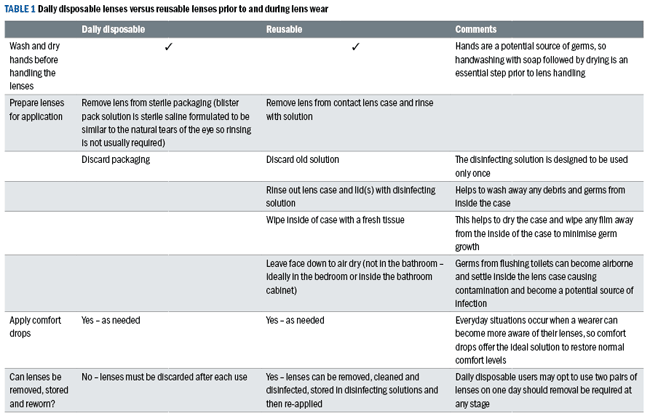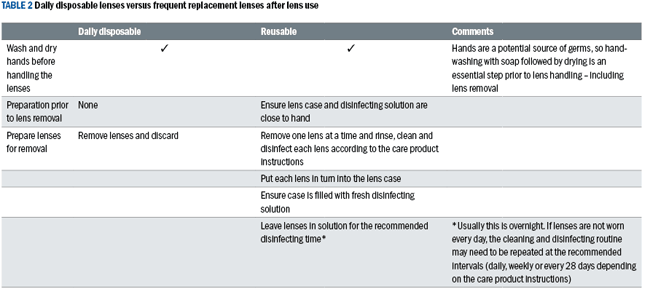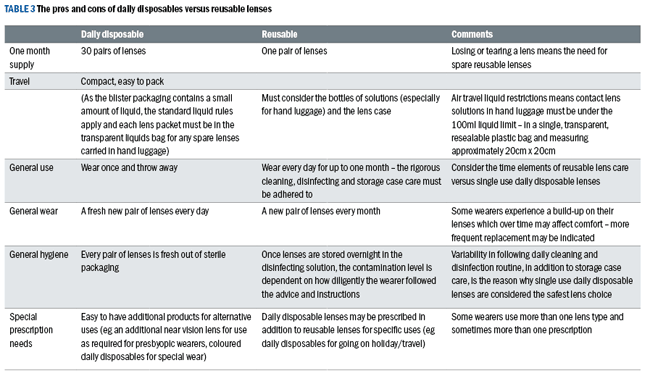[CaptionComponent="2598"]
When faced with someone who is asking about buying contact lenses (whether they are a new wearer, an existing wearer or even someone who has worn lenses in the past for a while but has given up – a lapsed wearer), lenses first need to suit the different prescription types (as discussed in the second article in this series).
But there are also different replacement frequencies to consider (eg daily, weekly, two-weekly, monthly) in addition to a range of different materials. This article considers these product differences and how this might influence eye care professional (ECP) recommendation and wearer choice.
Discovering the contact lens potential
‘I’ve often wondered if I might be suitable to try contact lenses, as many of my friends have them. I always mean to ask when I go, but I always forget. They’ve never suggested contact lenses to me, but that’s probably my fault, because I’ve never asked…’
A comprehensive research study of almost 3,000 potential contact lens wearers addressed the question of how many spectacle wearers present for their eye examination and ask about trying contact lenses.1 The study also uncovered the percentage of spectacle wearers who were recommended to try contact lenses by their ECP. The results were in some ways surprising.
Only 21% of eligible people ask their ECP if they can try lenses, and the rest do not ask, or forget to ask. During these consultations, the ECP selects around one-third of eligible people (who do not themselves ask about contact lenses) and discusses the notion of trying contact lenses.
This option is generally rejected with only two out of 10 people agreeing to give them a try. It is astonishing to think that over half (52%) of all spectacle wearers who could wear contact lenses neither ask about trying them nor does their ECP make the suggestion.1 Perhaps it is no surprise the contact lens market is considered to have significant growth potential.
Some ECPs hold the view that if someone does not ask for contact lenses, they are not sufficiently motivated to try them.
Another perspective is that the wearer wrongly concludes that because their ECP has not made a recommendation for contact lenses, this therefore means they must not be suitable. There is much to be discussed and much discussion omitted. Front of house staff can greatly assist by proactively uncovering interest in trying contact lenses.
For example, when someone telephones or calls in to make an appointment for an eye examination, asking whether the appointment is for spectacles or contact lenses is a great way to indirectly mention the prospect of contact lenses.
People who have wondered about trying them are more likely to engage in some discussion at this stage, and appropriate appointment time can be made available with the ECP, so that the discussion may be taken further – in addition to the possibility of trialling contact lenses during the course of their visit.
Many people feel some degree of fear of trying contact lenses because any experience of ‘having something in their eye’ (eg grit, dust, sand, an eyelash, soap, cosmetics) has been thoroughly unpleasant.
Many people think contact lenses are made from hard plastic, and although this is the case for rigid lenses, they could not be more wrong about soft lenses. It is very useful when introducing contact lenses to allow the person to touch and hold a lens.
Having a glass bowl of daily disposable lenses to hand for this purpose is a very engaging and interactive way to demonstrate the ‘nothingness’ of soft lenses. Many people are stunned by how thin and almost invisible a soft lens is to touch and feel. This helps to break down the barriers and allay some of the fears of trying lenses for the first time.
In 2007, a landmark study was conducted to establish the impact of a more indirect approach to introducing contact lens wear. The study was entitled ‘Enhancing the approach to selecting eyewear’ abbreviated to the EASE study.2
Instead of inviting all suitable spectacle wearers to try contact lenses (with a known success rate of around 22% to 33%), the spectacle wearers were asked if they would like to try a novel approach to choosing their new spectacle frames. A brief explanation was given that this involves the ECP putting on a lens to enable them to see without their spectacles. The lens was a contact lens, and they would use it purely to help them see the range of eyewear.
After this (usually around 30 minutes to an hour), the ECP would remove the lenses. The whole thing was kept low key, with the main aim facilitating the immediate benefit of being able to see to choose frames. There was no mention of ‘becoming a contact lens wearer’.
Of the people selected on the study to try this approach, almost nine out of 10 people said yes. This is dramatically different to the typical response when inviting someone to try contact lenses – when this is weighted more on the decision of becoming a contact lens wearer with the associated ongoing purchase of contact lenses.
Clearly, the offer is perceived very differently given the large number declining this latter approach. One hypothesis is that with the EASE approach, it is made clear that the ECP takes care of all the handling aspects and there is a direct and immediate benefit – facilitating a better experience of choosing frames.
Not being able to see clearly in the mirror (for people with minus prescriptions) or to focus at close range (for people with plus prescriptions as well as those with presbyopia) affects the confidence when shopping for new glasses. It is common for people to suggest they come back on another day with their partner or a trusted friend to advise them on this virtually ‘blind’ choice.
Using contact lenses to facilitate clearer vision (compared with how they see with no spectacles) puts them back in control. The study also impacted on the sales value, with those who wore contact lenses to select their eyewear spending an average 32% more on their spectacles (this was an increase in value of both the spectacle lenses as well as a higher priced frame).
Whilst not everyone went on to purchase contact lenses following this experience, one-third of them were sufficiently interested to continue with purchasing both contact lenses and new spectacles.
Whilst trying contact lenses can seem a logical consideration in light of both occupational and lifestyle needs and the freedom from spectacles that contact lenses deliver, the decision to try lenses may feel too big a step for some spectacle wearers to make.
The high level of rejection when this is tentatively suggested by ECPs indicates that significant barriers exist which cause suitable candidates to refuse the offer. Perhaps this is largely fear of the unknown:
• They may think they will have to apply and remove their lenses rather than this being done by the ECP at least on the first occasion
• They feel uncertain about the time it might take or the number of appointments required in the context of their already busy life
• They may have insufficient time on the day of the appointment at the moment the offer of a trial is made
• They may be wary of the cost
• They may focus on the fear of what might be an unpleasant experience rather than on the benefits of being able to see without spectacles
• They may be uncertain about whether or not their appearance will be better without spectacles or fear their appearance may change significantly.
Lens types — so much choice
It is useful to keep in mind that information about contact lenses is quite difficult to find. Most potential wearers and even current users have very limited knowledge of the wide range of products available.3 Wearers rely on the recommendation from their ECP and discussion with other staff.
While members of the public may have heard about disposable contact lenses, they may not appreciate that there are single use daily disposable lenses and reusable frequent replacement lenses (replaced monthly or more frequently).
Table 1 details the key differences in the user experience between daily disposable single use lenses versus frequent replacement lenses for a typical routine when applying the lenses for a day of wear. Table 2 illustrates the steps involved at the end of the wearing day.
The two tables make it clear that there is much more time involved when reusing contact lenses, as well as the added responsibility on the wearer to follow the recommended hygiene steps. It should be noted that both lens types require good hand hygiene practice irrespective of lens replacement frequency.
Whilst the convenience of daily disposability may be obvious, there are other elements to discuss when someone is considering the pros and cons of daily disposables versus reusable lenses as show in Table 3.
Insight into contact lens wear in the real world
Assuming a wearer is suitable for either daily disposables or reusable lenses, a discussion about the key user experiences around the two options is important. In addition to this, consideration is also given to the anticipated wearing pattern. For someone who wishes to wear their lenses all day every day, from the beginning of their day until bedtime, it is important to match this long wearing time with an appropriate lens material.
There are two key categories of soft lens materials: hydrogels and silicone hydrogels. The first ever soft lenses manufactured were made from a hydrogel material, which is a type of plastic containing water. These early materials typically had a moisture content of around 38% which is considered low compared with the hydrogels fitted today with water contents of around 55%-78%.
Not only does the water make the plastic soft and flexible, but it also allows oxygen to move through the lens and reach the surface of the eye. This is very important, as the eye surface is an unusual tissue as it relies mainly on absorbing oxygen from the air rather than receiving oxygen via the blood supply route. Current hydrogels continue to offer good oxygen performance, and certainly satisfy the requirements of the occasional wearer.
In 1999, the first silicone hydrogel lenses were launched. These had a low water content, but the oxygen breathability superseded the regular hydrogel materials as oxygen could pass through the silicone in the plastic and did not rely upon the water content. With silicone hydrogels, the water simply helped to keep the lenses softer.
The new generation silicone hydrogel materials now have higher water contents whilst maintaining excellent oxygen breathability, and these products offer the ultimate in oxygen performance for wearers who need to wear their lenses for long hours. This material has been shown to maintain the natural whiteness of the eyes due to their excellent ‘as if there’s almost no lens there’ oxygen flow.
For wearers whose lenses have more material thickness relative to other lens types (eg higher prescriptions, toric lenses for astigmatism) the silicone hydrogel material helps to maintain good oxygen delivery across the entire lens.
It is not unusual for contact lens wearers to nap in their lenses or perhaps even accidentally fall asleep in them. Whilst the majority of new wearers are prescribed lenses to be worn on a daily wear basis only (and not extended wear – sleeping in lenses), research has shown a greater safety margin with silicone hydrogel lenses.4
[CaptionComponent="2599"]The benefits of ongoing aftercare
From the previous two articles in the series, it is evident that ongoing support for a new wearer (especially in the first 60 days) is important in order that they achieve success with lenses.
Daily disposable lenses provide an excellent starting lens for many new wearers, and ongoing aftercare visits at intervals recommended by their ECP help ensure they are not only following the recommended advice on the wear and care of their lenses, but also that the current lenses they are using continue to match their wearing requirements.
Not all wearers appreciate the need for these visits, especially when they feel their lenses are excellent in terms of vision and comfort, but keeping in contact with their ECP allows them to stay up to date with the latest advice as well as not missing out on something new which may be even better than their current lenses.
Summary
Finding the ideal lens for a new wearer requires careful thought, good clinical assessment and some time for the new wearer to evaluate how contact lenses benefit them in their everyday life. Whilst their initial thoughts form a good starting point, this may change with their experience of lens wear.
More experienced wearers also deserve to be kept up to date with new developments, and providing them with updates and advice during their periodic visits is helpful when facilitating their ongoing success in lens wear.
There are many different types of contact lenses available, and it is well worth the time and effort in educating both potential and current wearers about what is new in contact lenses.
Next time…
Given the huge choice of contact lenses available, this can seem overwhelming when someone calls in or the phone rings and they ask ‘how much are contact lenses?’
Whilst the spectacle prescription dictates the choices open to them, explaining that there are many different types of contact lenses to suit both a wide range of prescriptions as well as catering for both full-time and occasional wear. Best practice on how to handle enquiries about contact lenses will be discussed.
Sarah Morgan BSc (Hons) MPhil, MCOptom, FAAO, FBCLA is an optometrist and an internationally recognised communication expert, and a vision sciences fellow at the University of Manchester
Read more
Part 1: ‘Contact lenses? I didn’t know I was able to wear them’
Part 2: Why are disposable contact lenses ideal for the new wearer?
Part 4: Dealing with enquiries about contact lenses
References
1 Morgan SL et al. American Academy of Optometry, San Antonio, Texas, USA. Academy ‘97: Annual Meeting. A nationwide survey of UK contact lens prescribing. (Poster) December 14, 1997.
2 Atkins, NP, Morgan, SL, & Morgan, PB. (2009). Enhancing the approach to selecting eyewear (EASE): A multi-centre, practice-based study into the effect of applying contact lenses prior to spectacle dispensing. Contact Lens and Anterior Eye, 32(3), 103–107.
3 Consumer Insights. YouGov. November 2015. Data on file.
4 Chalmers R et al, Rates of adverse events with hydrogel and silicone hydrogel daily disposable lenses. Invest Ophthalmol Vis Sci 2015; 56: 654-63
To view a highlights video from CooperVision's Ready for Today London event click here.



